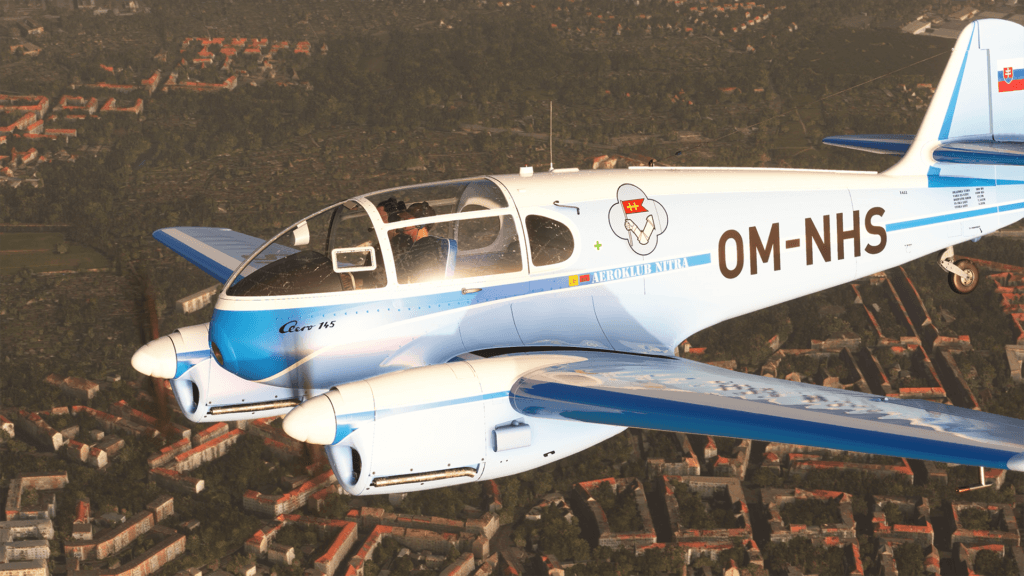Aero Vodochody of Czechoslovakia created one of the most distinctive airframes in aviation history in the late 1940s with the Ae-45, and now the prototype Ae-45 and the supercharged variant, the Ae-145, are coming to Microsoft Flight Simulator!
The Aero Vodochody Ae-45 “Aero” Family
The unveiling of Local Legend 11 coincides with the release of Microsoft Flight Simulator World Update 14: Central Eastern Europe, the aircraft family’s home skies.
The Ae-45 is a twin-engine, low-wing utility aircraft developed and manufactured by Aero Vodochody of Czechoslovakia. Frequently referenced as the “Aero,” it can accommodate up to five passengers, including two in the cockpit. It took its maiden flight on July 21, 1947, and was introduced in 1948. The Ae-145 is an advanced version of the original Ae-45 that features supercharged engines, refined avionics, improved flight controls, and an enhanced canopy. A total of 590 of all Aero variants were built during a production run that spanned from 1947 to 1961; 162 of these were Ae-145s, built between 1959 and 1963.
The Local Legend 11 pack includes the Ae-45 prototype and the Ae-145, each with a selection of liveries.
The Aero Vodochody Ae-45
The Ae-45, frequently referenced as the Aero 45, began as a concept in 1946 in the wake of World War II. A team of five Czechoslovak engineers sought to innovate an efficient, low-maintenance civil aircraft that could perform a variety of applications. Their work was fueled by national pride as much as by aerospace engineering aspiration; they sought to re-establish the Czechoslovakian aviation industry in the post-World War II era and propel it onto the global stage. They were so driven that they began working on and financing the concept on their own, without any state or industry sponsorship.
After roughly a year of toil, Aero Vodochody took notice and backed the engineers. The result was one of aviation’s most distinctive, rugged, and enduring performers. The all-metal design is made up of a high-visibility cabin, two powerful wing-mounted engines that provide speed and efficiency, and an innovative cockpit that maximizes pilot efficacy. Upon release, the Ae-45 (the 45 is a reference to it being a 4- or 5-seat aircraft) proved a fast, high-endurance, reliable craft that was easy to operate and maintain.
The aircraft’s engineers incorporated numerous features that were state-of-the-art for the era, including electrically-actuated propeller pitch gearboxes able to be pre-set using push button control (similar to an automatic transmission in an automobile). Designers also included electrical systems for flaps and landing gear control. These novel features were incorporated in the prototype and early iterations of the Aero 45 used systems adapted from previous aircraft, notably wartime German bombers like the Heinkel He 111. These components, adapted for production expediency, included magneto switches and engine diagnostic gauges.
The Aero 45 became an immediate success throughout Europe, with models being exported to France, the Netherlands, the United Kingdom, and other nations. Pilots raved about its cockpit visibility, range, speed, and reliability. The airframe was ultimately used by civil and military operators in dozens of countries for passenger transport, cargo, air ambulance, flight schools, law enforcement, and other purposes.
The Ae-45 established itself publicly soon after its release by winning a high-profile air race in Great Britain and by completing several long-range expeditions, notably in Africa. In 1958 it became the first Czechoslovakian aircraft to cross the Atlantic Ocean, flying from South America to Africa. Its initial successes set the stage for following iterations, and the series remained in production for 14 years. After years of robust export sales, the Czech aviation market adopted the Aero into widespread use at home. At this point its engineers had refined it and incorporated more advanced avionics, flight control, and power management systems.
No two of the few remaining Aero 45s are identical. Over the decades, private owners modified their airframes. Some of the most notable upgrades include cockpit instrumentation, particularly from modern Piper and Cessna aircraft, and cabin enhancements for comfort.
While many aviation museums throughout the globe display static examples of the Aero 45, only a small handful of fully functional airframes remain, making them a rare sight in today’s skies.
The Ae-45 measures 25 feet, 6 inches in length, stands 7 feet, 7 inches tall, and has a wingspan of 40 feet, 2 inches. It is powered by two inverted 4-cylinder Avia M 332-III piston engines that each deliver 140 horsepower and turn 2-blade, variable-pitch metal propellers. The Aero 45 has a range of 1,100 miles, a service ceiling of 19,400 feet above sea level, and a rate of climb of 980 feet per minute. It cruises at 160 miles per hour and has a top speed of 175 mph. The aircraft also operates well out of short and unimproved airfields, boasting a take-off run of 1,500 feet.
The Ae-45 is a no-nonsense, utilitarian airplane that has been charming aviators for decades with its reliability, power, and overall performance. Pilots can take flight in the craft for a wide variety of purposes, from practicing basic maneuvers to embarking on trans-oceanic or multi-continental journeys.
The Local Legend Ae-45 is a rendition of the prototype of the airframe and is available with four liveries: Prototype, Polished, OK-FHA, and Plain White.
The Aero Vodochody Ae-145
The Ae-145 is a twin-engine, low-wing utility aircraft developed and manufactured by Aero Vodochody of Czechoslovakia. The airplane can accommodate up to five, including two in its cockpit. It is a development of the original Ae-45, which took its maiden flight on July 21, 1947, and was introduced in 1948. A total of 162 Ae-145s were built between 1959 and 1963.
The Ae-145 features advanced flight controls, improved avionics, supercharged engines, more efficient power management systems, and a canopy offering greater visibility than that of the original Ae-45. The aircraft was ultimately used by civil and military operators in dozens of countries for passenger transport, cargo, air ambulance, flight schools, law enforcement, and other purposes.
Over the decades, private owners modified their airframes, and today no two of the few remaining Aero 145s are identical. Some of the most notable upgrades include cockpit instrumentation, particularly from modern Piper and Cessna aircraft, and cabin enhancements for comfort.
While many aviation museums throughout the globe display static examples of the Aero 45 and 145, only a small handful of fully functional airframes remain, making them a rare sight in today’s skies.
The Ae-145 measures 25 feet, 6 inches in length, stands 7 feet, 7 inches tall, and has a wingspan of 40 feet, 2 inches. It is powered by two inverted 4-cylinder Avia M 332-III piston engines that each deliver 140 horsepower and turn 2-blade, variable-pitch metal propellers. The Aero 145 has a range of 1,100 miles, a service ceiling of 19,400 feet above sea level, and a rate of climb of 980 feet per minute. It cruises at 160 miles per hour and has a top speed of 175 mph. The aircraft also operates well out of short and unimproved airfields, boasting a take-off run of 1,500 feet.
The Ae-145 is a stunning example of great looks and excellent performance resulting from aircraft designers adhering to the principle of utilitarianism during the creation process. The Ae-145 is a wonder in the air, for a wide spectrum of applications, and pilots of all skill levels will enjoy their time in the cockpit of this eye-catching machine for hours on end on flights all around the globe.
The Ae-145 is available with four liveries: OM-NHS, SP-LXH, Red-Cream, and Silver-Gold.
The Ae-45 and Ae-145 are available today in Microsoft Flight Simulator for USD $14.99. The sky is calling!
Microsoft Flight Simulator is available for Xbox Series X|S and PC with Xbox Game Pass, PC Game Pass, Windows, and Steam, and on Xbox One and supported mobile phones, tablets, and lower-spec PCs via Xbox Cloud Gaming. For the latest information on Microsoft Flight Simulator, stay tuned to @MSFSOfficial on Twitter.



